How Automation Can Help Streamline Your Product Assembly Process?

Automation has become an integral part of numerous industries, revolutionizing processes and enhancing productivity. In the realm of product assembly, automation holds immense potential for streamlining operations and improving overall efficiency.
In this article, we will explore how automation can help optimize your product assembly process, allowing you to deliver high-quality products while minimizing costs and time.
Understanding Automation in Product Assembly
Automation in product assembly refers to the use of technology and machinery to perform repetitive tasks that were traditionally carried out by humans.
These tasks can include picking and placing components, tightening screws, performing quality checks, and packaging finished products.
By automating these processes, businesses can eliminate human error, increase production speed, and improve overall accuracy.
Benefits of Automation in Streamlining Product Assembly
- Enhanced Efficiency: Automation significantly improves the speed and accuracy of product assembly, resulting in increased output and reduced production time.
- Reduced Costs: By automating repetitive tasks, businesses can minimize labor costs, as well as reduce errors and rework expenses.
- Improved Quality Control: Automation ensures consistent quality control throughout the assembly process, reducing defects and enhancing customer satisfaction.
- Optimized Resource Utilization: Automated systems can utilize resources more efficiently, allowing businesses to allocate their workforce to more complex and strategic tasks.
- Worker Safety: By automating hazardous or physically demanding tasks, businesses can prioritize worker safety and minimize the risk of accidents or injuries.
Implementing Automation: Best Practices
When integrating automation into your product assembly process, consider the following best practices:
- Thorough Process Analysis: Identify the tasks that can be automated and evaluate their feasibility and potential impact on the overall process.
- Investment Planning: Determine the budget and timeline required for implementing automation, including equipment costs, training, and system integration.
- Collaboration with Experts: Consult with automation specialists and suppliers who can provide valuable insights and recommend suitable solutions for your specific needs.
- Gradual Implementation: Implement automation gradually, starting with smaller-scale projects to test and refine the process before scaling up.
- Training and Workforce Adaptation: Provide proper training to your workforce to ensure smooth adoption of automation technologies and address any concerns or resistance.
- Continuous Monitoring and Improvement: Regularly monitor the automated processes, gather data, and analyze performance to identify areas for further optimization.
Overcoming Challenges in Automating Product Assembly
While automation brings numerous benefits, it also presents challenges that businesses need to address:
- Initial Investment: The upfront cost of automation can be substantial, requiring careful financial planning and evaluation of long-term returns on investment.
- System Integration: Integrating automation systems with existing infrastructure and software can be complex and may require specialized expertise.
- Workforce Adaptation: Some employees may be resistant to change or fear job displacement. Providing proper training and transparent communication is crucial to address these concerns.
- Maintenance and Upkeep: Automated systems require regular maintenance and occasional upgrades, which should be factored into the overall cost and operational planning.
- Flexibility and Scalability: Ensuring that the automated systems are flexible and adaptable to future changes in product design or assembly requirements is essential.
Future Trends in Automation for Product Assembly
The field of automation is constantly evolving, and several trends are shaping the future of product assembly:
- Collaborative Robots: Collaborative robots, also known as cobots, are designed to work alongside humans, enabling safe and efficient collaboration in assembly tasks.
- Artificial Intelligence: AI-powered systems can analyze data, make decisions, and optimize assembly processes in real-time, leading to further improvements in efficiency and quality.
- Internet of Things (IoT) Integration: By connecting assembly line components and machines through IoT, businesses can gather real-time data for predictive maintenance and process optimization.
- Advanced Vision Systems: Vision systems equipped with advanced cameras and sensors can enhance quality control by detecting defects and abnormalities with high accuracy.
- Automation as a Service: Cloud-based automation platforms offer scalable and flexible solutions, allowing businesses to implement automation without significant upfront investments.
Automation is a powerful tool that can revolutionize the product assembly process, enabling businesses to streamline operations, improve efficiency, and deliver high-quality products to their customers.
To stay competitive in the rapidly evolving market, it is crucial for businesses to explore the potential of automation and implement it strategically in their product assembly workflows. Or you can choose to work with a manufacturer that has highly automated their production process, such as Shield Works, one with their own in-house facility and 18 years of industry experience, always looking to innovate their manufacturing expertise. Contact us today!
Exploring Different Types of Product Assembly Options for Your Business
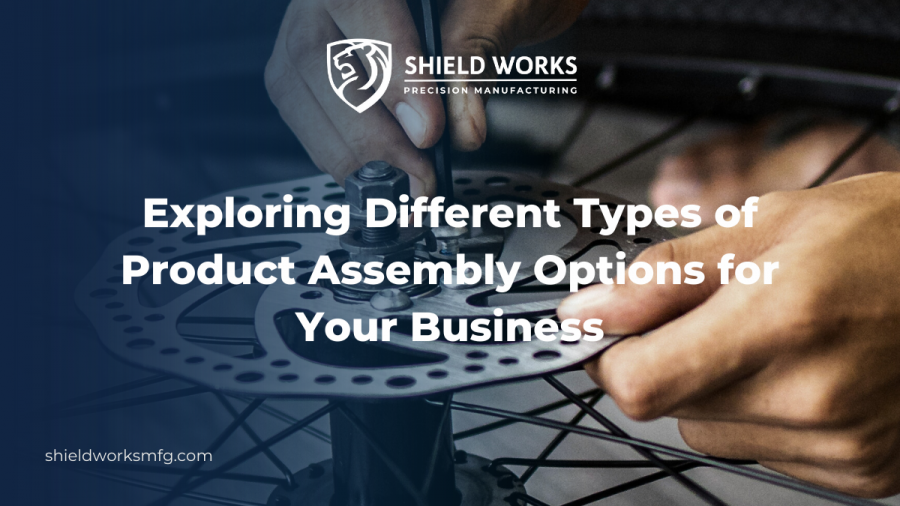
Did you know the business process outsourcing segment in China was worth $15.03 billion in 2021?
Grand View Research says the growth is due to investments in the IT infrastructure of major Chinese cities. There have been similar investments in smaller Chinese cities as well.
Does your company think about product assembly options in China? If so, it pays to explore the various product assembly strategies.
Continue reading to learn about different kinds of product assembly options.
Assemble-to-Order
If you’re considering a China assembly service, one option is the assemble-to-order strategy.
This strategy calls for assembling an inventory of components. When customers place orders, the manufacturer uses the parts to make the products.
The assemble-to-order strategy requires the manufacturer to assemble and dispatch products after receiving orders. It needs to be done fast. Creating an organized inventory is, therefore, essential.
When you partner with a reputable and experienced outsourcer in China, you won’t have anything to worry about. At Shield Works, we’ll make product-order projections based on the following:
- Historical information
- Market conditions
- Macroeconomic trends
Products can be customized by customers since the products are not assembled until after the customers place orders.
It’s one strategy employed by providers of product assembly services.
Make-to-Order
Another product assembly strategy is the make-to-order option. It’s one of the product assembly services in China.
The product assembler can only start the process after receiving confirmation of a client order.
Advantages of the made-to-order method include the following:
- Customization to meet customers’ needs
- Less waste
However, the disadvantages of this manufacturing process include the following:
- Longer wait times
- Higher costs
So, you’ll want to weigh whether the benefits outstrip the disadvantages for your company. You can count on us at Shield Works to give you our honest, professional assessment.
Finding an outsourcing partner with operations in China will offer you a competitive advantage. And you won’t have to sit up at night worrying about your product assembly operations.
Make-to-Stock
The make-to-stock manufacturing strategy is another option. It calls for creating products and stocking them until customers place orders. Demand forecasts, driven by experienced outsourcers, drive this strategy.
There are some drawbacks to this method, such as the following:
- Expenses associated with holding onto unsold inventor
- Potential for stocked products to become obsolete
One manufacturing method you’ll want to consider is the make-to-stock option. It’s a good option if you’re considering product assembly in China.
Get in touch with us at Shield Works Precision Manufacturing. We can consider your situation to determine what strategy best fits your business.
Assembly Simulation and Testing
Yet another assembly option to consider is assembly simulation and testing. It’s about getting things off on the right foot. We conduct assembly trials and process optimization to help the product development cycle.
Before rolling out any project, we’ll work with customers to simulate the assembly process. You can determine expenses and get insights into the effectiveness of the process.
Undergoing this process will help reduce expenses, cut production lead times, and help with quality control.
If you’re considering product assembly in China, don’t overlook assembly simulation and testing. It might be the right option for you.
Disassembly, Re-Assembly, and Repacking Services
We’ll remove the current packaging and put the product in new packaging. You’ll get to choose the new packaging.
This service can be useful if you must repackage for any of the following reasons:
- Products must be inspected before delivery
- Products must be placed in the correct packaging after having been put in the wrong packaging
When you partner with us at Shield Works, we’ll guarantee quick turn-around times for repackaging projects. We can also help with disassembling and reassembling products before repackaging.
Repetitive Manufacturing
Do you want to contact manufacturing in China for help with your product assembly needs? One option is repetitive manufacturing.
It’s a worthwhile manufacturing strategy as it offers repeat production at a consistent and reliable rate.
Repetitive manufacturing requires dedicated production lines to assemble the same product or component. Since the production lines focus on a single product or part, you can scale up or down to meet demand.
Prototype Assembly Projects
Do you require assistance with prototype assembly? If so, we have what you’re looking for. We understand that prototyping is an essential part of the manufacturing process.
You can count on us to build prototypes to optimize solutions. We offer an end-to-end prototyping assembly service. Get in touch to find out how you can take advantage of this service.
Batch Process Manufacturing
This manufacturing process is driven by customer demand. Using this strategy, an outsourcer can create batches of products after getting orders.
After completing the order, the third party will clean up the equipment. That means the equipment will be ready for service when the next batch order arrives.
Companies in the publishing industry tend to gravitate toward the batch process.
Continuous Process Manufacturing
Continuous process manufacturing runs all the time. It mostly focuses on raw materials in the form of liquids, gases, and powders.
So, it’s worth considering if the product is something like peanut butter, tomato sauce, or beverages.
Do You Need Help With Product Assembly?
You can now see that various product assembly options are available. Outsourcing the process to an overseas third party makes sense.
At Shield Works Precision Manufacturing, we have you covered. We have experience helping businesses find suitable outsourcing options. You owe it to yourself to explore the benefits of outsourcing product assembly.
Do you need product assembly, contract manufacturing, OEM manufacturing, warehousing, or distribution services? There are benefits to finding a service provider in China. Need more information? Contact us today to learn more.
The Hidden Risks of Contract Manufacturing in China without Proper Quality Controls
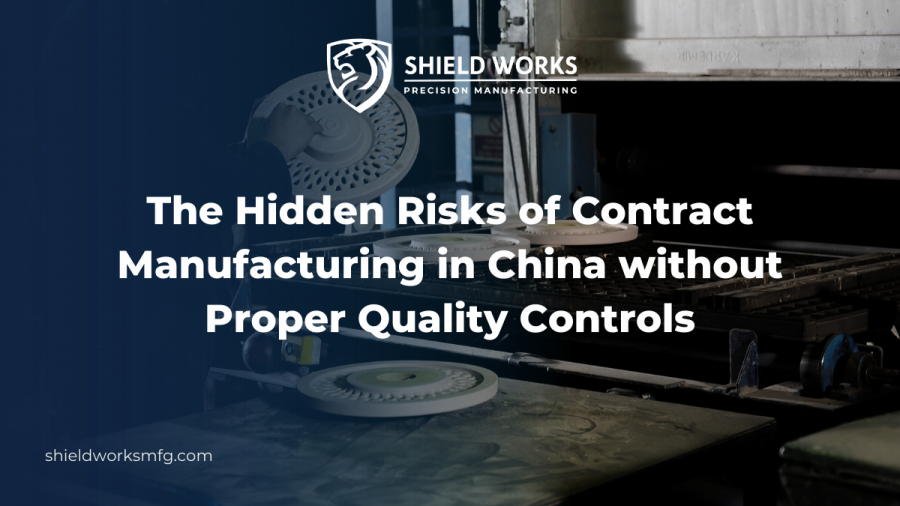
Although China has become an attractive option for many businesses due to its cost-effective production capabilities, the hidden risks of contract manufacturing in China without proper quality controls can lead to serious problems. Without the right level of quality control, businesses may find themselves with inferior products, delayed shipments, and high rework costs – all of which can have a detrimental effect on their reputation and profitability. When considering contract manufacturing in China, many companies in the West know the importance of maintaining high quality standards, but they may lack awareness of the specific issues that can arise and how to mitigate them.
In this blog, we will delve into the hidden risks associated with outsourcing manufacturing to China without implementing the necessary quality control measures. Let’s explore these risks in detail.
The Risks of Overlooking Quality Controls
Overlooking quality controls can expose businesses to various risks and negative consequences. Quality controls are essential in ensuring that products or services meet the desired standards and specifications. Here are some of the risks associated with overlooking quality controls:
1. Compromised Product Quality
Without proper quality controls, there is a higher chance of encountering compromised product quality. This can include defects, inconsistencies, substandard materials, or poor workmanship. Inferior product quality can lead to customer dissatisfaction, increased returns, and damage to the company’s reputation.
2. Safety Hazards
Neglecting quality controls can result in safety hazards for consumers. Products that do not meet safety standards or contain defects may pose risks to users, leading to injuries or accidents. This can result in lawsuits, product recalls, and significant financial liabilities for the business.
3. Decreased Customer Satisfaction
Quality control measures ensure that products or services consistently meet customer expectations. When quality is overlooked, customer satisfaction may decline, leading to negative reviews, decreased customer loyalty, and a loss of market share.
4. Damage to Brand Reputation
A lack of quality controls can harm a company’s brand reputation. Negative experiences with poor-quality products can spread quickly through word-of-mouth, social media, and online reviews, tarnishing the brand’s image. Rebuilding trust and recovering from a damaged reputation can be a long and challenging process.
5. Increased Costs
Overlooking quality controls can result in higher costs in the long run. This includes expenses related to rework, product returns, customer compensation, and potential legal actions. Poor-quality products may also lead to lost sales opportunities, reduced profitability, and increased marketing efforts to regain customer trust.
Ensuring Product Quality Through Proper Inspections
Inspections play a vital role in identifying any defects, inconsistencies, or deviations from the desired specifications. Here are some key aspects to consider when conducting inspections to ensure product quality:
1. Supplier Selection and Vetting
Selecting the right supplier is the first step in ensuring high-quality production in China. Before choosing a supplier, it is important to conduct a thorough vetting process. This process involves assessing the supplier’s experience, capabilities, and quality standards.
When vetting potential suppliers, start by reviewing their credentials and past performance. Check for any certifications, awards, or industry recognition they may have received. It is also important to examine their manufacturing facilities and processes to ensure they have the necessary infrastructure and technology to meet your production needs.
2. Implementing Quality Control Processes and Standards
Once you have selected a reliable supplier and established a good working relationship with them, the next step is to implement quality control processes and standards. This involves setting clear quality expectations, ensuring compliance with industry regulations and standards, and monitoring the manufacturing process to identify and address any quality issues.
It is also important to communicate your quality requirements to your supplier, and to provide clear instructions and feedback on any quality issues that are identified. Regular communication with your supplier is key to maintaining a strong quality control system, and it is important to be proactive in identifying and addressing any issues as soon as they arise.
3. Monitoring and Maintaining Quality Over Time
Maintaining high quality standards in Chinese manufacturing is not a one-time task. Once you’ve established proper quality controls and selected reliable suppliers, it’s important to continuously monitor and maintain quality over time.
It’s also essential to stay up-to-date on industry trends and regulations that may impact your products’ quality, especially when your product requires specific certifications or compliance standards, you must ensure that your suppliers are aware of these requirements and have the necessary documentation to prove compliance.
4. Hire a Third-Party Quality Control Team
Clearly, implementing all the inspection works by yourself can be too much. Hiring a third-party quality control team is an effective approach to managing inspections without overwhelming your own resources.
Third-party inspection teams specialize in quality control and have extensive knowledge and experience in assessing product quality. Their expertise ensures comprehensive inspections, covering all relevant aspects of the manufacturing process. By working with experienced inspectors, you are able to focus on your production in order to gain the best outcomes.
5. Work with Reputable a Contract Manufacturing Company
For many overseas companies, working with a Western-owned contract manufacturing company in China can provide a sense of reassurance. These trusted manufacturers have extensive industry experience, possessing the necessary knowledge, technical expertise, and specialized equipment to deliver high-quality products. Their expertise enables them to proactively identify and address potential quality issues, resulting in superior overall product quality.
If you are seeking a contract manufacturing company that prioritizes your security requirements, Shield Works is the ideal choice. As a British-owned and managed company, we specialize in providing contract manufacturing and product assembly services at competitive rates without compromising on quality. Our commitment to excellence is reflected in our rigorous processes, ensuring consistent quality from the moment you place an order until the delivery of the final product.
Begin your journey with Shield Works today by reaching out for more information. We are dedicated to making every penny you invest worthwhile by delivering exceptional quality and meeting your specific manufacturing needs.
Key Elements of Manufacturing Contracts You Should Know

In the world of manufacturing, contracts play a crucial role in establishing and regulating business relationships between manufacturers and their clients. These legal agreements outline the terms and conditions under which goods are produced, ensuring that both parties are protected and their rights and obligations are clearly defined.
This article will delve into the key elements of manufacturing contracts that every business owner should be familiar with. By understanding these essential components, you can enter into contracts confidently, safeguard your interests, and foster successful partnerships.
Parties Involved
The first fundamental element of a manufacturing contract is identifying the parties involved. This section should clearly state the names and contact details of both the manufacturer and the client.
It’s essential to accurately represent the legal entities or individuals entering into the agreement to avoid any confusion or disputes in the future. Including a brief description of each party’s business activities can also provide context and establish the nature of the relationship.
Scope of Work
The scope of work section defines the specific products or services to be manufactured by the supplier. It should include detailed descriptions, specifications, and any relevant technical documentation.
This section serves as a blueprint for the manufacturing process, ensuring that both parties are on the same page regarding the expected deliverables. Clear and concise language is essential in this section to minimize the risk of misinterpretation or ambiguity.
Pricing and Payment Terms
One of the most critical aspects of any manufacturing contract is the pricing and payment terms. This section should outline the agreed-upon pricing structure, including the cost per unit, any applicable discounts, and payment milestones.
Specify the payment method, whether it’s a lump sum, installment, or a combination of both. Additionally, include details about late payment penalties, currency, and any additional charges such as taxes or shipping fees. By clearly defining the financial aspects, this section ensures transparency and minimizes financial disputes.
Quality Assurance and Inspection
To maintain product quality and ensure customer satisfaction, a manufacturing contract should include provisions for quality assurance and inspection. Clearly define the quality standards, testing procedures, and acceptance criteria that the manufactured goods must meet.
This section should also outline the rights and responsibilities of both parties concerning inspection and quality control. By setting these parameters, you can mitigate the risk of receiving substandard products and establish a process for resolving quality-related issues.
Intellectual Property Rights
Intellectual property (IP) rights are of paramount importance in manufacturing contracts. This section should address ownership and protection of intellectual property associated with the manufacturing process, such as patents, trademarks, copyrights, and trade secrets.
Specify who will retain ownership of any new inventions or improvements made during the manufacturing process. Additionally, outline confidentiality obligations to safeguard sensitive information shared between the parties. Clear guidelines on intellectual property protect your innovations and prevent unauthorized use or disclosure.
Term and Termination
The term and termination section establishes the duration of the manufacturing contract and the circumstances under which either party can terminate the agreement. Clearly state the contract’s start date and end date, as well as any provisions for renewal or extension.
Include details on the notice period required for termination and any consequences or penalties associated with early termination. A well-defined termination clause ensures that both parties have a clear understanding of their rights and obligations throughout the contract’s duration.
Dispute Resolution
In the event of a dispute or disagreement, having a clearly defined dispute resolution process can help resolve issues efficiently and avoid costly litigation. This section should outline the preferred method of dispute resolution, such as negotiation, mediation, or arbitration. Specify the jurisdiction and venue for any legal proceedings.
It’s crucial to include a provision for resolving disputes amicably before resorting to legal action. A well-crafted dispute resolution clause promotes fair and timely resolution, preserving the business relationship between the manufacturer and the client.
Manufacturing contracts are vital tools for establishing successful business relationships in the manufacturing industry. By understanding the key elements of these contracts, you can ensure that your manufacturing agreements are comprehensive, fair, and beneficial to all parties involved.
Working with a manufacturer like Shield Works will make the process much easier. Our western background and 18 years of experience will provide a solid foundation for your manufacturing endeavors, minimize risks, and promote long-term success. Call us today!
Tips to Make Your Contract Manufacturing Process in China Easier
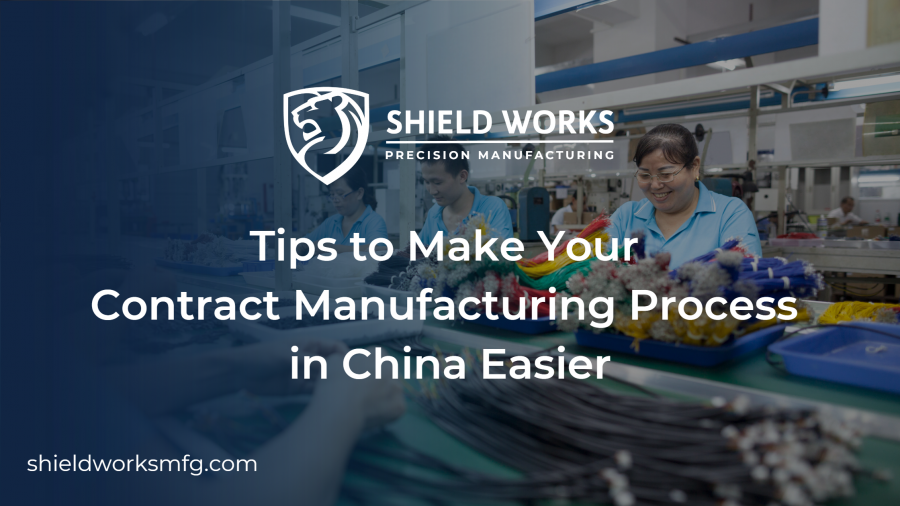
Contract manufacturing in China has become increasingly popular for businesses looking to reduce costs and take advantage of the country’s manufacturing capabilities.
However, navigating the contract manufacturing process in China can be complex and challenging, especially for those who are unfamiliar with the local business practices and cultural nuances.
In this article, we will provide you with valuable tips to make your contract manufacturing process in China easier, enabling you to optimize your operations and achieve successful outcomes.
Understanding the Chinese Manufacturing Landscape
Before diving into the tips, it’s important to have a clear understanding of the Chinese manufacturing landscape. China is renowned for its vast manufacturing infrastructure, which offers a wide range of capabilities and cost advantages.
From electronics to textiles, China has a diverse array of industries capable of meeting various production requirements. Additionally, the country boasts a skilled workforce and a strong supply chain network, further enhancing its appeal as a contract manufacturing destination.
Conduct Thorough Supplier Research
When engaging in contract manufacturing in China, conducting thorough supplier research is crucial. Look for reputable manufacturers with a proven track record in your industry. Request references and samples of their previous work to assess the quality of their products.
Make sure to verify their certifications, licenses, and compliance with international standards. Performing due diligence on potential suppliers will help you identify reliable partners and minimize the risk of working with subpar manufacturers.
Establish Clear Communication Channels
Effective communication is key to a successful contract manufacturing process. Establish clear and open lines of communication with your Chinese manufacturing partner. Overcome language barriers by hiring translators or working with bilingual staff.
Utilize video conferencing tools and project management software to facilitate real-time communication. Regularly scheduled meetings and written documentation can help ensure that both parties are on the same page regarding product specifications, timelines, and any potential issues that may arise during production.
Visit the Manufacturing Facilities
Whenever possible, plan a visit to the manufacturing facilities in China. Seeing the production process firsthand will provide valuable insights into the manufacturer’s capabilities, quality control procedures, and overall operations.
It also allows you to build stronger relationships with the suppliers, fostering trust and understanding. During your visit, take the opportunity to discuss any concerns or questions you may have, and use this face-to-face interaction to establish a solid foundation for a long-term partnership.
Emphasize Quality Control
Maintaining quality control is essential when outsourcing your manufacturing to China. Clearly define your quality standards and expectations, and ensure that your Chinese manufacturing partner understands and implements them effectively.
Implement regular inspections and quality assurance procedures to identify and rectify any issues early on. Conducting third-party inspections and audits can provide an unbiased assessment of the manufacturing process and product quality, offering you additional assurance.
Understand Intellectual Property (IP) Protection
Protecting your intellectual property is of utmost importance when working with Chinese manufacturers. While China has made significant strides in strengthening IP protection laws, it is still crucial to take necessary precautions.
File patents, trademarks, and copyrights in China to safeguard your designs and technologies. Implement non-disclosure agreements (NDAs) and confidentiality clauses to protect your trade secrets. Consult with legal experts who specialize in Chinese intellectual property laws to ensure comprehensive protection.
Build Strong Relationships
Building strong relationships with your Chinese manufacturing partners is a valuable long-term strategy. Cultivate trust and respect through open and transparent communication.
Establishing personal connections through regular visits, cultural exchanges, and social engagements can help foster a strong partnership. Invest time in understanding Chinese business culture and etiquette to avoid misunderstandings. By building strong relationships, you increase the likelihood of receiving priority treatment, improved cooperation, and enhanced mutual understanding.
Plan for Potential Challenges
While contract manufacturing in China offers numerous benefits, it is important to acknowledge and plan for potential challenges that may arise. Be prepared for delays in production, shipping, or customs clearance due to unforeseen circumstances. Maintain buffer time in your project schedule to account for these uncertainties.
Have contingency plans in place to mitigate any risks that may affect your supply chain or production timeline. Being proactive and adaptable will help you navigate challenges and ensure smooth operations.
Engaging in contract manufacturing in China can be a game-changer for businesses seeking cost-effective production solutions. By following these tips, you can streamline your contract manufacturing process and overcome common hurdles.
Remember, with careful preparation and a strategic approach, such as a manufacturer like Shield Works, with their own assembly facility, rich industry experience, and vast network of suppliers, you can make your contract manufacturing process in China easier and reap the benefits of this global manufacturing powerhouse. Contact us to know more!
Contract Manufacturing Companies: 5 Tips for Choosing Your Best Option
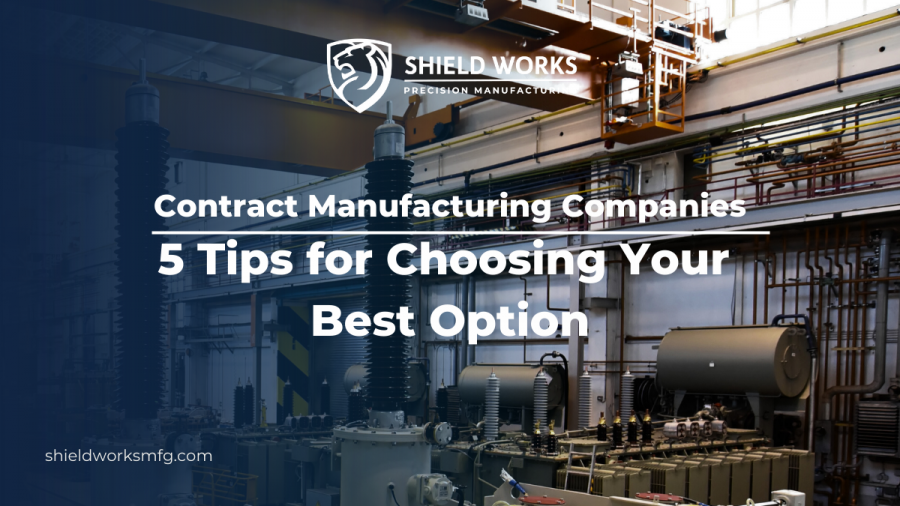
Are you ready to make a move to get a product prototype manufactured to see it come to real life? This can be an extremely exciting moment in the process of being successful. However, you want to make sure that you are choosing your best option. How do you know which contract manufacturing companies are the best? How do you go about choosing one? In this guide, we’ll walk you through what you need to know to choose the best one out there. By following these tips, you’ll see your product come to life in no time!
1. Know What You Need a Contract Manufacturing Company For
The first thing that you need to do when you are looking for the best manufacturing company is to define what you need them for. There are most likely specific requirements that you have for a project, so knowing what they are can help you figure out what company is going to work best for you. For instance, you need to consider your product specifications, how much of your product you need, the quality standards that you expect, delivery expectations, price, and more. When you are looking into these, discussing them with a contract manufacturing company will make sure that you are choosing the right one for your needs.
2. Determine Their Expertise and Knowledge of the Industry
You don’t want to work with a manufacturing company that doesn’t have the right experience or knowledge about the product that you need. While they may be extremely experienced in another industry, that doesn’t mean that they have the same experience in your industry! It is important to be able to tell the two apart. This is where research comes into play. You will want to look for companies that have a proven track record and history of expertise in your industry. They should have history with manufacturing similar items or products. It doesn’t need to be the same — but similar means that they know what they are doing for you. In addition to expertise, you should ensure that they are qualified because this is part of what helps you determine their expertise. For instance, they should be able to fully meet your manufacturing requirements based on their equipment, employees, and technology that they utilize in their plant.
3. Ask for References and Testimonials
Before you agree to work with a manufacturing company, you need to ask for reviews and testimonials. A lot of times, you can find these yourself on their website. You can also read reviews on Google (which we highly recommend). However, a reputable company should be able to provide references and testimonials to you if you ask them. If they don’t provide anything, it is best for you to move on to a different company that will. It can be a red flag if they don’t have any references, as this either means they don’t have any experience or no one wanted to leave a great review for them. These customer reviews, and testimonials can provide a lot of insight into the company you could be working with in terms of their strengths and weaknesses as well as how well they get the job done.
4. Consider Logistics of the Supply Chain
You don’t want to get started with a manufacturing job before thinking about the logistics of it all. For instance, you need to think about what the manufacturer is going to need to do for you. First, they need to create the products that you want from them. They need to gather the supplies to do so and have the labor to get it done. You should be looking around and assessing the company to see if they would be able to do this for you. You know your wants and needs, and you can see if they are able to meet that. You should also have a conversation with them about their shipping, packaging, and distribution logistics so you have a better understanding of what that looks like and who is in charge of that — them or you.
5. Always Visit the Site
While it can be extremely convenient to sit at your desk and research companies online and then call a few that you think would be a great fit, this is not going to be great for your manufacturing. You need to actually visit the site to see what it is all about. When you are on the phone, you can get a false idea of the contract manufacturing company. However, if you pay them a visit, you will be able to see what you are getting yourself into and if it is going to work for you. This way, you can see their team, their equipment, and the entire manufacturing plant as a whole. Visiting will give you a better gut feeling about whether it is the right company for you or not.
Tips for Choosing Contract Manufacturing Companies
If you want to make sure that you are choosing contract manufacturing companies that are right for you and the industry that you are in, then you will want to follow these tips. You should always do your due diligence with the research of various companies, learning their knowledge and expertise for your industry, asking for testimonials, and personally visiting the site.
Are you ready to work with the best companies out there? You can contact us today at Shield Works Precision Manufacturing to get the job done!
Choosing the Right Product Assembly Company: Assembly Locally VS. Assembly in China
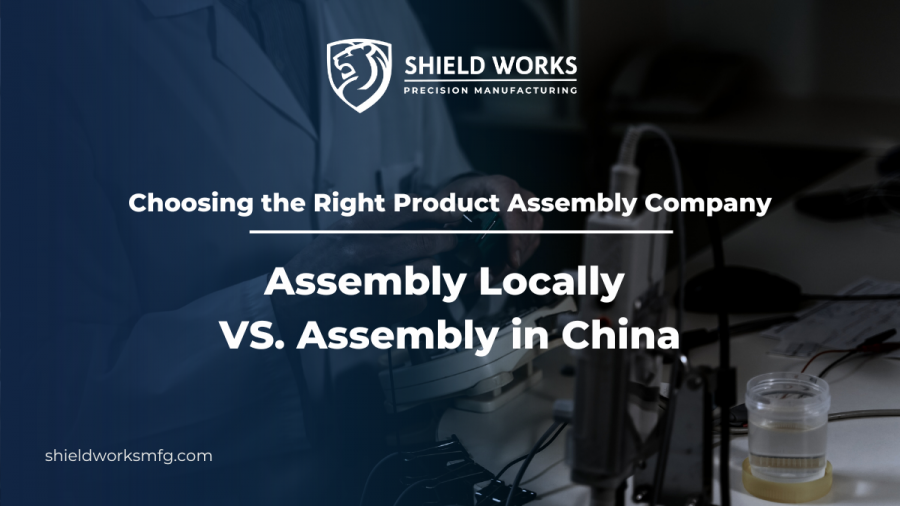
In today’s globalized economy, businesses face crucial decisions when it comes to product assembly. Many companies in the West are continually seeking cost-effective and efficient ways to assemble their products. One of the most significant choices is whether to assemble products locally or outsource the assembly process to other countries in Asia like China. Both local assembly and assembly in China offer distinct advantages and challenges, making it essential for businesses to weigh their options carefully.
In this blog post, we will explore the benefits and drawbacks of both local and overseas product assembly companies to help you decide which option is right for you. Let’s dive right in!
Domestic Assembly VS. Overseas Assembly
Domestic assembly refers to the process of assembling products within the same country where they will be sold or consumed. On the other hand, overseas assembly involves manufacturing and assembling products in a foreign country and then exporting them back to the home country.
Assembly Locally: The Advantages
Easier Factory Audits and Inspections
You can often visit the facility and see firsthand how they assemble your products. When you opt for local assembly, it becomes more convenient and accessible for you to perform thorough inspections during the assembly process.
Communication and Collaboration
Working with a local assembly company facilitates clear and effective communication. You can easily interact with the assembly team, provide instructions, and discuss any modifications or requirements face-to-face. This reduces the chances of miscommunication and ensures that your vision for the product is accurately conveyed.
Faster Turnaround
Local assembly generally results in faster turnaround times since there are no delays associated with shipping products from overseas. This can be particularly beneficial if you have time-sensitive projects or need to respond quickly to market demands.
Reduced Logistics Costs
By assembling locally, you can avoid expensive international shipping costs, import duties, and customs fees. This can help lower your overall production costs and increase your profit margins.
Assembly Locally: The Disadvantages
Higher Labor Costs
Local assembly often comes with higher labor costs compared to countries with lower wage rates, such as China. This can impact your overall production costs and potentially reduce your profit margins, especially if you have labor-intensive products or large-scale manufacturing operations.
Capacity Constraints
Local assembly companies may have limited capacity or scalability, particularly if your product demands high-volume production. They might struggle to meet your production targets within the desired timeframe. This can be a challenge if you anticipate rapid growth or sudden spikes in demand.
Competition and Supplier Options
In some industries or locations, the options for local assembly companies might be limited. This can result in increased competition for available assembly services, potentially leading to higher costs or reduced flexibility in choosing a suitable partner. Limited supplier options may also affect the negotiating power or availability of assembly resources.
Assembly China: The Advantages
Cost Savings
China has long been known for its cost-effective manufacturing capabilities. Labor and production costs are generally lower compared to many other countries. This can be advantageous if you’re operating on a tight budget or require large-scale production.
Specialized Expertise
China has a well-established manufacturing industry and is home to numerous experienced assembly companies. They have the expertise and resources to handle complex manufacturing processes and can offer specialized services, such as precision machining or advanced electronics assembly.
Scale and Capacity
China’s manufacturing infrastructure allows for large-scale production and the ability to handle high-volume orders. If you anticipate significant demand for your product or require mass production, assembling in China can accommodate your needs more efficiently.
Assembly China: The Disadvantages
Language and Communication Barriers
Language differences can pose communication challenges when working with Chinese assembly companies. It may require additional effort and resources to ensure effective communication and understanding of your product requirements, specifications, and quality standards.
Intellectual Property Concerns
Intellectual property protection can be a concern when assembling products in China. There have been instances of counterfeit products and intellectual property infringement. It’s crucial to have strong legal agreements, enforceable contracts, and intellectual property protection strategies in place to safeguard your designs, innovations, and trade secrets.
Quality Control and Product Standards
While China has many reputable assembly companies, there can be variations in quality control standards across different suppliers. It’s essential to thoroughly vet potential partners, visit their facilities, and establish stringent quality control measures to ensure that the final product meets your standards consistently.
Factors to Consider Before Making a Wise Decision
Clearly, there are pros and cons of assembly in your home country and in China. If you want to make a wise decision that aligns with your business goals and requirements, it’s important to consider several key factors. These factors will help you avoid financial losses and reach successful outcomes. Here are some factors to consider:
Budget Analysis
Conduct a comprehensive budget analysis comparing the total expenses associated with local assembly versus assembly in China. Know your budget limits and how you want to spend the costs. Consider labor costs, production expenses, shipping and logistics costs, import/export duties, taxes, and any other relevant financial factors. Assessing the cost implications will help you determine the most economically viable option for your business.
Quality Requirements
Evaluate your product’s quality standards and determine whether local assembly or assembly in China can consistently meet those requirements. Consider the quality control processes, inspection procedures, and track record of the assembly companies you are considering. Ensure that the chosen option can deliver the desired level of quality consistently.
Production Volume
Assess the expected production volume of your product. If you anticipate large-scale production or have significant demand, assembly in China might be more suitable due to its capacity for mass production. However, for smaller production volumes or specialized products, the local assembly company may be a better fit, providing more flexibility and customization options.
Supply Chain Considerations
Evaluate the availability and efficiency of your supply chain in both local and Chinese markets. Assess factors such as access to raw materials, components, and suppliers. Consider the reliability, cost, and lead times associated with each option. A robust and efficient supply chain is crucial for the smooth production and timely delivery of your products.
Intellectual Property Protection
If your product involves proprietary designs or intellectual property, carefully evaluate the intellectual property protection measures in both local and Chinese contexts. Consider the legal frameworks, enforcement mechanisms, and the track record of IP protection in each location. Protecting your intellectual property rights is essential for long-term success and preventing unauthorized use or infringement.
Why Should You Work with a Western-owned Product Assembly Company in China?
Choosing whom to work with for your assembly project won’t be an easy task. Keep in mind to work with companies that specialize in your industry and have experience in your field. Avoid those offering products and services way outside their expertise, as you’ll find they are likely more concerned with placing orders than quality, customer service, and business relationships. They will just place an order, fulfill it, and disappear – they won’t stay around to guide you through manufacturing hurdles.
If you are seeking a comprehensive product assembly company, Shield Works is an excellent choice. As a trusted provider, we offer a wide range of services customized to meet your specific needs. With our British ownership and management, we possess a deep understanding of both Western and Chinese cultures, facilitating effective communication and collaboration throughout the process. With several years of experience operating in China, we have specialized in contract manufacturing and product assembly, ensuring exceptional quality and providing value-added support. Our stringent processes guarantee consistency and excellence from the moment you place your order until delivery. By choosing Shield Works as your product assembly company, you can benefit from our extensive experience, commitment to quality, and dedication to customer satisfaction. Take the first step today by reaching out to us for more details and discovering the true value we bring to the table.
Efficient Assembly Lines: How to Optimize Productivity in China

Product assembly is a critical part of the manufacturing process. To remain competitive in today’s market, companies must focus on optimizing their assembly lines to achieve maximum efficiency and productivity.
However, optimizing product assembly in China requires a unique set of strategies and approaches due to the country’s complex labor laws and cultural nuances.
In this blog post, we will discuss some effective methods for optimizing product assembly workflows in China, helping companies in the West achieve their production goals in China while minimizing costs and improving quality.
Understanding the Current Assembly Workflow
Before you can optimize your product assembly workflows in China, you need to have a clear understanding of your current workflow. This means examining every step of the process, from receiving raw materials to shipping out finished products. By doing this, you can identify areas where your process is working well, as well as areas where it needs improvement.
Start by mapping out your workflow in detail, using flowcharts or diagrams to visualize each step. This will help you identify any unnecessary or redundant steps that may be slowing down your process. You should also pay close attention to the different handoffs and transfers that occur throughout the workflow, as these are often a source of delays and mistakes.
During this process, you should also take the time to talk to the people who are actually doing the work. This could include factory workers, quality control inspectors, or logistics coordinators. They can provide valuable insight into what works well and what needs improvement in your current workflow.
Identifying Bottlenecks and Waste
After knowing the current assembly process, then you need to identify any bottlenecks or waste in your production process. This involves analyzing your current process and identifying some main bottlenecks, including the movements and tasks of your workers, the flow of materials, and any machinery or equipment used in the assembly line.
One common bottleneck is when a specific worker or machine is responsible for a crucial task in the assembly process, causing delays if they are absent or overworked. In addition, waiting times for materials, equipment, or even other workers can slow down production and create unnecessary waste.
Waste can take many forms, such as overproduction, excess inventory, or defects in the final product. It is important to analyze the entire process to find any inefficiencies that are causing waste and to take steps to eliminate or minimize them.
Implementing Lean Principles
Lean principles have been successfully applied in many manufacturing industries to reduce waste and improve productivity. The core principles of lean are based on creating more value with fewer resources, focusing on continuous improvement, and respecting people.
When it comes to product assembly workflows, here are some Lean principles that can be applied:
1. Value Stream Mapping
Value stream mapping is a technique used to visualize the flow of materials and information in a production system. It can help identify bottlenecks and areas where waste is generated. Once identified, these areas can be targeted for improvement.
2. Just-in-Time (JIT) Production
JIT production is a method of manufacturing where production is triggered by customer demand rather than being pushed by a production schedule. By producing only what is needed, when it is needed, JIT production can reduce inventory levels, shorten lead times, and minimize waste.
3. Standardization
Standardization is the process of developing a set of best practices and procedures that can be followed by everyone involved in the assembly process. Standardization can help reduce errors, improve quality, and make it easier to train new employees.
4. Continuous Improvement
Continuous improvement is a process of making small, incremental improvements to a production process over time. By continually looking for ways to improve, even small gains can add up to significant productivity gains over time.
5. Visual Management
Visual management involves using visual aids such as color coding, labels, and signs to make it easier to understand the status of the production process. By making information more visible, it becomes easier to identify problems and take corrective action.
Training and Employee Engagement
One of the most crucial aspects of optimizing product assembly workflows is to ensure that your employees are well-trained and engaged. Well-trained employees are more productive and make fewer mistakes, leading to fewer quality issues and less rework, offering better suggestions and taking ownership of their work.
To improve training and employee engagement, consider the following tips:
1. Regular Training
Regular training sessions should be provided to ensure that your employees stay up-to-date with the latest tools and techniques. This will not only help them perform their job better but will also make them feel more confident and empowered.
2. Clear Communication
Clear communication is vital for effective training. Use visual aids and simple language to ensure that employees understand what is expected of them and how to perform their tasks correctly.
3. Feedback and Recognition
Providing feedback and recognition to your employees can motivate them to perform better and increase their engagement levels. Acknowledge their contributions, recognize their achievements, and provide constructive feedback to help them improve.
4. Team Building Activities
Team-building activities are an effective way to build employee engagement, foster collaboration and improve communication. Activities like off-site retreats, sports games, or even potluck lunches can help employees feel more connected to each other and the organization.
Work With a Western-owned Product Assembly Company in China
Many overseas companies may feel more comfortable working with a Western-owned product assembly supplier in China because they can provide you with a range of benefits, from cultural understanding and quality control to IP protection and access to expertise. It can be a strategic choice to optimize your manufacturing and assembly processes while ensuring a smooth and reliable partnership.
If you’re in search of a comprehensive security solution provider, Shield Works is your answer. As a trusted provider, we offer a range of services tailored to meet your needs. With our British ownership and management, we bring a deep understanding of both Western and Chinese cultures, ensuring effective communication and collaboration. Being in business in China for serval years, we specialize in contract manufacturing and product assembly services, offering exceptional quality and value-added support. Our stringent processes guarantee consistency and excellence from the moment you place your order until delivery. Take the first step by reaching out today for more details and experience the true value we bring to the table.
Understanding the Risks of Order Consolidation
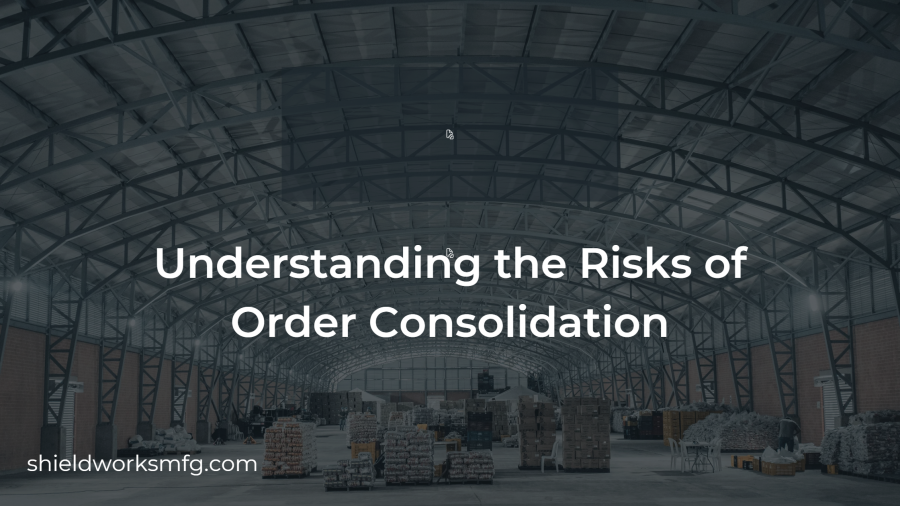
In today’s fast-paced business landscape, order consolidation has become a popular strategy for streamlining supply chain operations and optimizing costs. By combining multiple orders into a single shipment, companies can minimize transportation expenses, reduce inventory holding costs, and enhance overall efficiency. However, it is crucial to be aware of the potential risks associated with order consolidation. This article aims to shed light on these risks, their impact on businesses, and provide practical solutions for mitigating them effectively.
Inventory Management Challenges
One of the primary risks associated with order consolidation lies in inventory management. When multiple orders are consolidated, it becomes essential to manage inventory levels accurately to meet the varying demand of individual customers. Without proper control, there is a higher likelihood of stockouts or overstocking, leading to dissatisfied customers or unnecessary carrying costs. Implementing robust inventory management systems and leveraging advanced forecasting techniques can help strike the right balance and minimize these risks.
Increased Lead Times
Order consolidation often involves the synchronization of different orders from various locations, suppliers, or customers. This synchronization process can increase lead times, resulting in delayed deliveries and potential customer dissatisfaction. It is vital for businesses to closely monitor lead times and establish clear communication channels with all stakeholders involved in the consolidation process. By improving coordination and employing real-time tracking solutions, companies can minimize the impact of increased lead times on customer satisfaction.
Quality Control Issues
Consolidating orders can sometimes introduce quality control challenges. With multiple orders combined into a single shipment, there is a risk of overlooking or missing defects, especially when the individual orders have varying quality standards. To mitigate this risk, businesses should implement stringent quality control processes at various stages of the consolidation process. Conducting thorough inspections, implementing quality checkpoints, and establishing effective feedback loops can help maintain consistent product quality and customer satisfaction.
Increased Transportation Risks
While order consolidation offers cost-saving benefits by reducing transportation expenses, it also introduces certain transportation risks. Combining multiple orders into a single shipment increases the value and volume of the cargo, making it an attractive target for theft or damage during transit. To mitigate these risks, businesses should invest in robust security measures, such as GPS tracking systems, tamper-proof packaging, and insurance coverage. Additionally, selecting reliable logistics partners with a proven track record can help ensure the safe and timely delivery of consolidated orders.
Regulatory Compliance Challenges
Order consolidation often involves compliance with various regulations, especially when dealing with international shipments. Failure to comply with these regulations can result in penalties, delays, or even legal issues. To mitigate regulatory compliance challenges, companies should stay updated with the latest rules and requirements in the relevant jurisdictions. Establishing strong relationships with customs brokers, conducting regular audits, and maintaining accurate documentation can help ensure smooth order consolidation while adhering to legal and regulatory obligations.
Customer Expectations and Communication
Consolidating orders may impact customer expectations and communication. Customers accustomed to receiving individual shipments may be surprised or disappointed when their orders are combined. To manage customer expectations effectively, businesses should proactively communicate the benefits of order consolidation, such as reduced costs and enhanced sustainability. Additionally, providing accurate tracking information, timely updates, and exceptional customer service can help maintain transparency and build trust with customers.
Order consolidation can be a valuable strategy for optimizing supply chain operations and reducing costs. However, it is crucial to understand the associated risks and implement appropriate measures to mitigate them effectively.
Striking a balance between cost-saving measures and potential drawbacks is essential to achieve a streamlined and efficient supply chain while ensuring customer satisfaction and long-term success in today’s competitive business environment.
If you are new to this business with a need for order consolidation partnerships, feel free to contact Shield Works!
Streamlining OEM Sourcing: Best Recommendations & Tips

When it comes to Original Equipment Manufacturer (OEM) sourcing, efficiency and effectiveness are crucial for businesses. Streamlining the process of finding and selecting OEM suppliers can significantly impact a company’s productivity, cost-savings, and overall success. In this article, we will explore the best recommendations and tips to streamline OEM sourcing, enabling businesses to optimize their supply chain management and achieve their goals.
Understanding OEM Sourcing
Before diving into the recommendations and tips, it’s essential to understand what OEM sourcing entails. OEM sourcing involves partnering with external manufacturers to produce components, parts, or products that will be sold under a company’s brand name. This strategic approach allows businesses to leverage specialized expertise and resources while focusing on their core competencies.
Assessing Your Requirements
To streamline the OEM sourcing process, start by assessing your requirements thoroughly. This step involves understanding your product specifications, quality standards, production volume, budget constraints, and delivery timelines. Consider the following recommendations:
- Conduct a comprehensive product analysis: Define the exact specifications and features required for your product. This analysis will help you communicate your requirements effectively to potential OEM suppliers.
- Determine quality standards: Specify the quality standards that your product must meet. This ensures that your OEM supplier can deliver products that align with your brand’s reputation.
- Evaluate production volume: Assess your anticipated production volume to identify suppliers capable of meeting your demand. This evaluation will help you avoid overcapacity or undercapacity issues.
- Define budget constraints: Determine your budget limitations and negotiate pricing with potential suppliers accordingly. Balancing cost and quality is crucial in selecting the right OEM partner.
- Establish delivery timelines: Set realistic delivery timelines and ensure that your OEM supplier can meet your deadlines consistently.
Conducting Market Research
To streamline OEM sourcing, thorough market research is essential. By exploring various options and assessing potential suppliers, you can make informed decisions. Consider the following tips:
- Identify potential suppliers: Utilize industry directories, online platforms, and trade shows to identify potential OEM suppliers. Look for reputable manufacturers with experience in your industry and the desired product category.
- Evaluate supplier capabilities: Assess the capabilities and strengths of potential suppliers. Consider factors such as production capacity, technology, certifications, quality control processes, and their track record with other clients.
- Request samples and prototypes: Request samples or prototypes from shortlisted suppliers to evaluate their product quality, design, and functionality. This step ensures compatibility with your requirements.
- Check references and reviews: Seek references from other clients who have worked with the shortlisted suppliers. Additionally, check online reviews and ratings to gain insights into their reputation and customer satisfaction.
- Consider geographical proximity: Depending on your requirements, consider the advantages of working with suppliers in close proximity. Proximity can lead to faster communication, reduced shipping costs, and better control over production processes.
Building Strong Partnerships
Once you have identified potential OEM suppliers, building strong partnerships is crucial for long-term success. Follow these recommendations to foster productive relationships:
- Communication and collaboration: Establish open lines of communication with your OEM suppliers. Maintain regular contact to address any concerns, provide feedback, and ensure a shared understanding of expectations.
- Clearly define roles and responsibilities: Clearly outline the roles and responsibilities of both parties involved. This clarity helps prevent misunderstandings and promotes efficient collaboration.
- Establish quality control processes: Work with your OEM suppliers to develop comprehensive quality control processes. Regular audits and inspections can help ensure consistent product quality and adherence to specifications.
- Implement performance metrics: Define key performance indicators (KPIs) to assess your OEM suppliers’ performance. Track metrics such as on-time delivery, defect rates, and customer satisfaction to measure their effectiveness.
- Foster continuous improvement: Encourage your OEM suppliers to invest in innovation and continuous improvement. Collaborate on finding ways to optimize production processes, enhance product quality, and reduce costs.
Streamlining OEM sourcing is a critical step in optimizing your supply chain management. By assessing your requirements, conducting thorough market research, and building strong partnerships, you can streamline the process and achieve improved efficiency, cost-savings, and product quality. Embrace these recommendations and tips to ensure a successful OEM sourcing experience for your business. Remember, effective sourcing can give you a competitive edge in today’s dynamic business landscape.
Working with a manufacturer like Shield Works can help take off a lot of pressure of finding the right supplier too. With 18 years of experience in the industry and an expansive network of 500+ suppliers in Asia, you can always count on their professional service. Contact us now!
